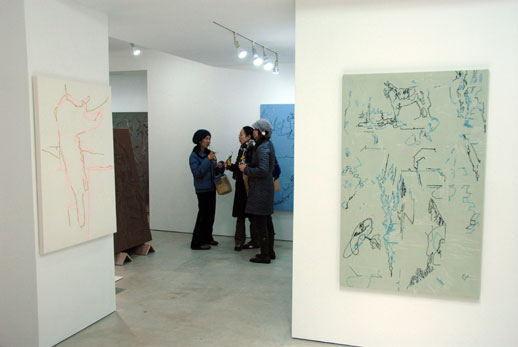Cloth and Tracery
Embroidery is women’s work, as they say. It is a pleasant domestic diversion, hand-fiddling, a lightweight decorative art of floral motifs and cute animals. It is also a medium fallen by the wayside in contemporary art. Far less likely materials have been rounded up into gallery installations, but embroidery has so far seemed doomed to a kind of marginal, homespun status among artistic media.
Certain embroidery artists, like the Egyptian Ghada Amer, have made that marginality the point of their work. Choosing to work in this self-confining medium, Amer’s embroidered tableaux show women performing various domestic tasks like cooking and cleaning, but also a layer of “secret” pornographic images of those same women hidden in among the threads. A seemingly docile piece of handiwork was thereby turned into a veiled commentary on gender stereotyping and sexual oppression, all pulled off with the unassuming air of a quietly scheming mistress bent over her busy needles…

Zon Ito is another contemporary artist who has taken up this neglected medium and turned its perceived weaknesses into an expressive idiom. Unlike Amer, however, there is nothing comparable in shock value to read between the threads, and certainly no political agenda. Some of Ito’s canvases are so slight and unassuming – in terms of both subject matter and delineation of image – that your sight has trouble alighting on its surface for long enough to observe it properly. His lines of thread give every appearance of delineating an outline – or at least a glimmer of a recognizable silhouette – but the thread obscures as much as it reveals. A common device he uses is the flipping back and forth of positive and negative space, of figure and ground, so that his figures and objects are embroidered just as often as they are not.
The viewer’s perspective undergoes a similar shifting process, shuttling from flat graphic surface, to isometric view, to Cubist play of depth. At the end of it, however, his work is staunchly non-pictorial. The threads are so slender and insubstantial that they end up only being a whispered suggestion of an image. What’s more, Ito’s attempt at delineation literally frays at the edges – with the thicker threads especially – and this gives the work a textural roughness that underlines its craft-like nature, helping to further break down its faint graphic qualities. Like a magical quilt with hidden references sewn into it, Ito’s embroidery is a loose constellation of colored wisps that appeals to some subconscious awareness of figuration hidden within.
The finer weights of thread are sewn together so tightly in some of the canvases that they give the impression of high-resolution pixellation – an effect that is accomplished using a method that could not possibly be more analog. This graphic density is offset by a certain airiness in some of the lighter, pastel colored works, which resemble a kind of pastoral dream sequence: animal and plant motifs are interwoven into an airy mural, where abstract patterns and lines dissolve into outlines of animals you only think you recognize.
The recognition is made more difficult by the fact that there is little to help you make those associations. There is no narrative in the tableaux, no obvious associative relationship between two objects even if they seem to melt into each other. Because of the varying weights of thread and the different densities at which they are woven, any associative chain of images seems to dissolve at the point where you think they start to come together. Now you see it, now you don’t.
Ito has succeeded in reaching a strange halfway point between abstraction and figuration. Just as the images in his embroidery straddle a woozy state between linear abstraction and half-traced figuration, his canvases themselves are a kind of craftwork that simultaneously imitates and shirks away from the condition of painting. The blips of thread that weave in and out of the cloth canvas trace a pattern that is continuous with the ground it is sewn onto, and yet the thread is also the tentative beginning of a figure that hovers just at the edge of delineation. With these canvases, Ito shows us the fragile border where figuration threatens to dissolve into dream and metaphor.
Darryl Jingwen Wee
Darryl Jingwen Wee



